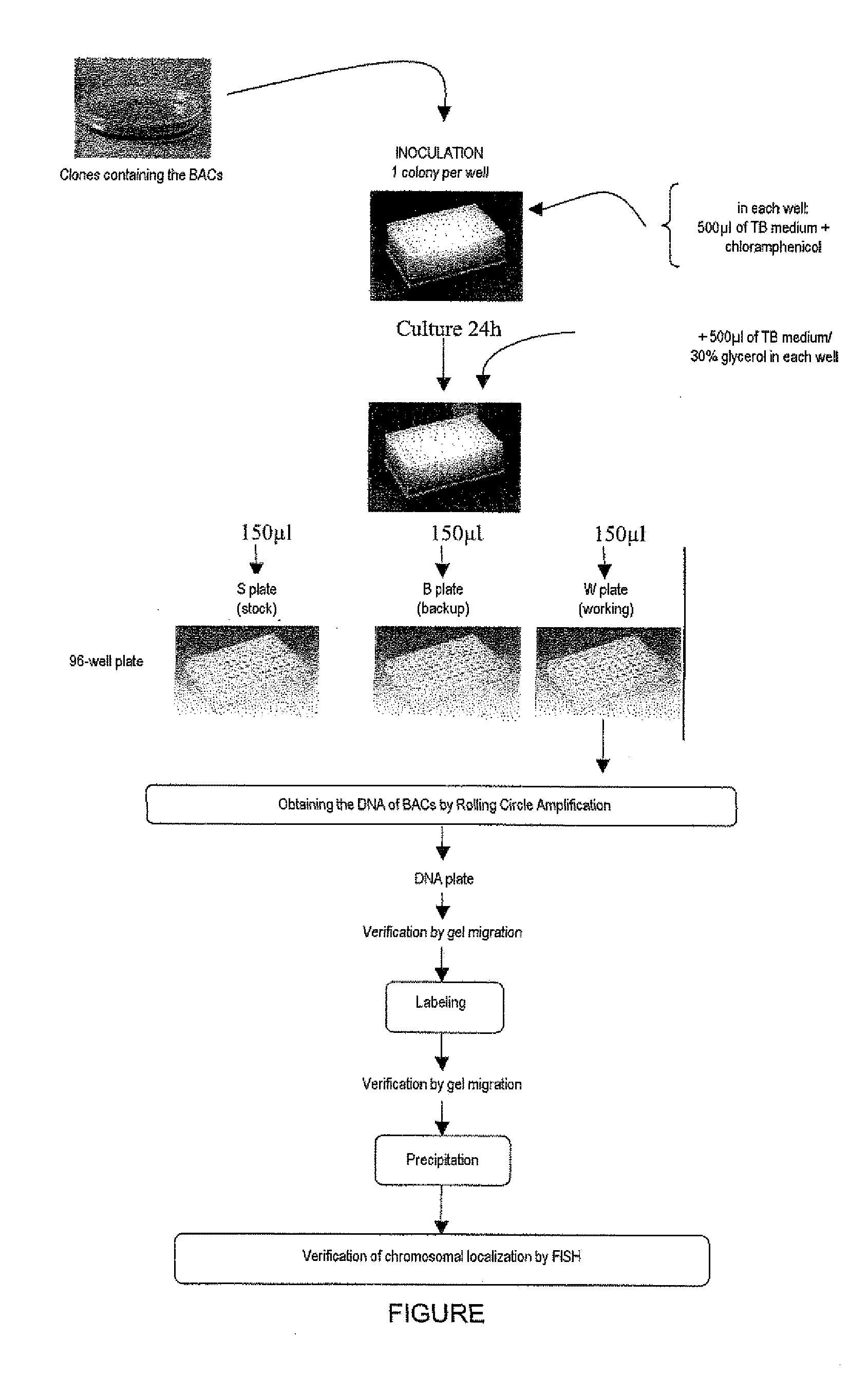Method for detecting chromosomal abnormalities
a chromosomal abnormality and chromosome technology, applied in the field of chromosomal abnormalities detection, can solve the problems of inability to detect chromosome preparations, inability to achieve prerequisites for chromosome preparations, and inability to detect telomeric regions of the same size and shade (generally black) of the same color
- Summary
- Abstract
- Description
- Claims
- Application Information
AI Technical Summary
Problems solved by technology
Method used
Image
Examples
example 1
Construction of 41 telomeric probes
[0055]The probes are prepared from BACs (Bacterial Artificial Chromosomes). A BAC is a fragment of human DNA, generally between 150 000 and 200 000 base pairs (150 kb-200 kb) in size, inserted into a plasmid transfected into E. coli.
[0056]Various internet sites allow the position of these BACs along each chromosome to be visualized. By consulting the UCSC site (http: / / genome.ucsc.edu / ), the inventors selected 286 BACs located in the subtelomeric regions specific to the long and short arms of all the chromosomes, with the exception of those of the short arms of the 5 acrocentric chromosomes (13, 14, 15, 21 and 22) which are composed of repeat sequences common to these 5 chromosomes. For the 41 ends, (23 chromosomal pairs minus 5), the BACs were selected in a contiguous state over a distance of at least 800 000 base pairs (800 kb) so as to obtain a probe generating a powerful signal.
TABLE 2Characteristics of the probes used (telo dist = telomere dis...
example 2
Production of the MTP (“Mega Telomeric Probes”) System
[0073]The strategy adopted resulted in the production of 41 probes which are labeled by means of a combination of 5 fluorochromes: FITC, rhodamine, DEAC, biotin (revealed with streptavidin-Cy5) and digoxigenin (revealed with Cy5.5).
[0074]The ends of the same chromosome are labeled with the same color combination.
2.1 Labeling of the Two Groups
[0075]Each group was constructed in such a way as to avoid bringing together chromosomes resembling one another from a cytogenetic point of view (21 and 22, in two different groups, for example).
[0076]All the ends which contain the same fluorochrome are labeled together by nick-translation and according to tables 3A and 3B below. For group I, 1960 ng of DNA were labeled with FITC, 2120 ng with rhodamine, 1050 ng with coumarin, 1983 ng with biotin and 1860 ng with digoxigenin, in respective volumes of 83, 98, 50, 88 and 84 μl. For group II, 1810 ng were labeled with FITC, 1860 ng with rhodamin...
example 3
Demonstration of a Balanced Subtelomeric Translocation t(5; 1)(q35; p15)
[0082]In order to test the resolution of the probes, the inventors carried out a hybridization of said probes in a patient with acute myeloid leukemia associated with a cryptic telomeric abnormality, t(5; 11)(q35; p15), therefore invisible by conventional cytogenetics.
[0083]This translocation recombines the NUP98 gene encoding a 98 kDa nucleoporin located at 3 Mb from the telomere of the short arm of chromosome 11 and the NSD1 gene encoding a nuclear receptor SET domain protein located at 4 Mb from the telomere of the long arm of chromosome 5.
[0084]The resolution of the band karyotype is 5 to 10 Mb (often 10 Mb for the chromosomes of leukemic cells). The MTP system of the invention made it possible to easily detect this abnormality.
[0085]In order to confirm that it is indeed a translocation reorganizing the distal end of the long arm of a chromosome 5 and that of the short arm of a chromosome 11, the inventors h...
PUM
| Property | Measurement | Unit |
|---|---|---|
| Fraction | aaaaa | aaaaa |
| Fraction | aaaaa | aaaaa |
| Length | aaaaa | aaaaa |
Abstract
Description
Claims
Application Information
 Login to View More
Login to View More - R&D
- Intellectual Property
- Life Sciences
- Materials
- Tech Scout
- Unparalleled Data Quality
- Higher Quality Content
- 60% Fewer Hallucinations
Browse by: Latest US Patents, China's latest patents, Technical Efficacy Thesaurus, Application Domain, Technology Topic, Popular Technical Reports.
© 2025 PatSnap. All rights reserved.Legal|Privacy policy|Modern Slavery Act Transparency Statement|Sitemap|About US| Contact US: help@patsnap.com

